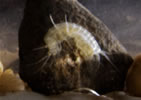Slugs and snails are examples of Molluscs. Most of the living molluscs in caves are gastropods and many are omnivores – like man they feed on a variety of food types. Many produce chitinase enzymes to digest the chitin in the exoskeletons of insects e.g. Cellar snail Oxychilus cellarius.
The Glass snails, in the genus Oxychilus, are the snails most commonly recorded from Mendip caves, including Oxychilus draparnaldi, O. helveticus, O. cellarius and O. alliarius, as well as Vitrea crystallina, another glass snail species. Other species include the Common Door Snail Clausilia bidentata, the Rounded Snail Discus rotundatus, Arion ater, Helicella caperata, Cepaea hortensis, Helix pomatia and Retinella nitidula. Most of these species are found amongst detritus in the threshold zone. Oxychilus cellarius, O. draparnaldi, Discus rotundatus and Vitrea crystallina can be found quite deep in the threshold, even within the dark zone, tucked away in damp crevices.
|
Glass Snail Oxychilus sp. in Fairy Cave |
The freshwater Wandering Snail Radix balthica (formerly Lymnaea peregra) has been recorded in Stoke Lane Slocker and was no doubt washed in from the surface.
Another unusual record is that of two dead winkle (Littorina littorea) shells in Gough’s Cave and it is thought that these might be remains from when the Mendip Hills formed the coastline along this part of Somerset in the past.
The Great Grey Slug (Limax maximus) has been recorded from the threshold of Lamb Leer Cavern and Agriolimax agrestis has been found in Stoke Lane Slocker.
The Bivalves (so named because they have two shells (valves) joined together by a hinge) are another group of molluscs found in both fresh and marine waters. Marine bivalves include creatures like the cockles and razor shells etc. Freshwater bivalves rarely occur in caves, although the Pea Mussel Pisidium nitidum has been recorded from Pen Park Hole.
|



